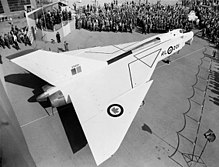| Canada in the Cold War era | |||
|---|---|---|---|
| 1946–1991[note 1] | |||
 Roll-out for the Avro Arrow in October 1957 | |||
| Including | 1945–60, 1960–81, 1982–92 | ||
| Leader(s) | W. L. Mackenzie King Louis St. Laurent John Diefenbaker Lester B. Pearson Pierre Trudeau Joe Clark John Turner Brian Mulroney | ||
Chronology
| |||
This article needs additional citations for verification. (July 2016) |
Canada in the Cold War was one of the western powers playing a central role in the major alliances. It was an ally of the United States, but there were several foreign policy differences between the two countries over the course of the Cold War. Canada's peacekeeping role during the Cold War has played a major role in its positive global image.[3][4] The country served in every UN peacekeeping effort from its inception in 1948 until 1989.[5] This resulted in Canada provided the greatest amount of UN peacekeepers during the Cold War.[6][7]
Canada was a founding member of the North Atlantic Treaty Organization (NATO) in 1949, the North American Aerospace Defence Command (NORAD) in 1958, and played a leading role in United Nations peacekeeping operations—from the Korean War to the creation of a permanent UN peacekeeping force during the Suez Crisis in 1956. Subsequent peacekeeping interventions occurred in the Congo (1960), Cyprus (1964), the Sinai (1973), Vietnam (with the International Control Commission), Golan Heights, Lebanon (1978), and Namibia (1989–1990).
Canada did not follow the American lead in all Cold War actions, sometimes resulting in tensions between the two countries. For instance, Canada refused to join the Vietnam War; in 1984, the last nuclear weapons based in Canada were removed; diplomatic relations were maintained with Cuba; and the Canadian government recognized the People's Republic of China before the United States.
The Canadian military maintained a standing presence in Western Europe as part of its NATO deployment at several bases in Germany—including long tenures at CFB Baden-Soellingen and CFB Lahr, in the Black Forest region of West Germany. Also, Canadian military facilities were maintained in Bermuda, France, and the United Kingdom. From the early 1960s until the 1980s, Canada maintained weapon platforms armed with nuclear weapons—including nuclear-tipped air-to-air rockets, surface-to-air missiles, and high-yield gravity bombs principally deployed in the Western European theatre of operations as well as in Canada.
- ^ "Gouzenko Affair". historyofrights.ca. University of Alberta. 2020. Retrieved 21 June 2020.
- ^ Herd, Alex; McIntosh, Andrew (27 May 2020). "Canada and the Cold War". The Canadian Encyclopedia. Historica Canada.
- ^ Sorenson, David S.; Wood, Pia Christina (2005). The Politics of Peacekeeping in the Post-cold War Era. Psychology Press. p. 158. ISBN 978-0-7146-8488-8.
- ^ Sobel, Richard; Shiraev, Eric; Shapiro, Robert (2002). International Public Opinion and the Bosnia Crisis. Lexington Books. p. 21. ISBN 978-0-7391-0480-4.
- ^ "Canada and international peacekeeping". Veterans Affairs Canada. Mar 25, 2009. Retrieved Feb 26, 2024.
- ^ Dorn, Walter (March 17, 2013). "Canadian Peacekeeping No Myth" (PDF). Royal Canadian Military Institute. Retrieved February 28, 2024.
- ^ Dorn, A. Walter; Libben, Joshua (2018). "Preparing for peace: Myths and realities of Canadian peacekeeping training". International Journal. 73 (2). [Sage Publications, Inc., Sage Publications, Ltd., Canadian International Council]: 257–281. ISSN 0020-7020. JSTOR 26499686. Retrieved February 29, 2024.
Cite error: There are <ref group=note> tags on this page, but the references will not show without a {{reflist|group=note}} template (see the help page).
© MMXXIII Rich X Search. We shall prevail. All rights reserved. Rich X Search

